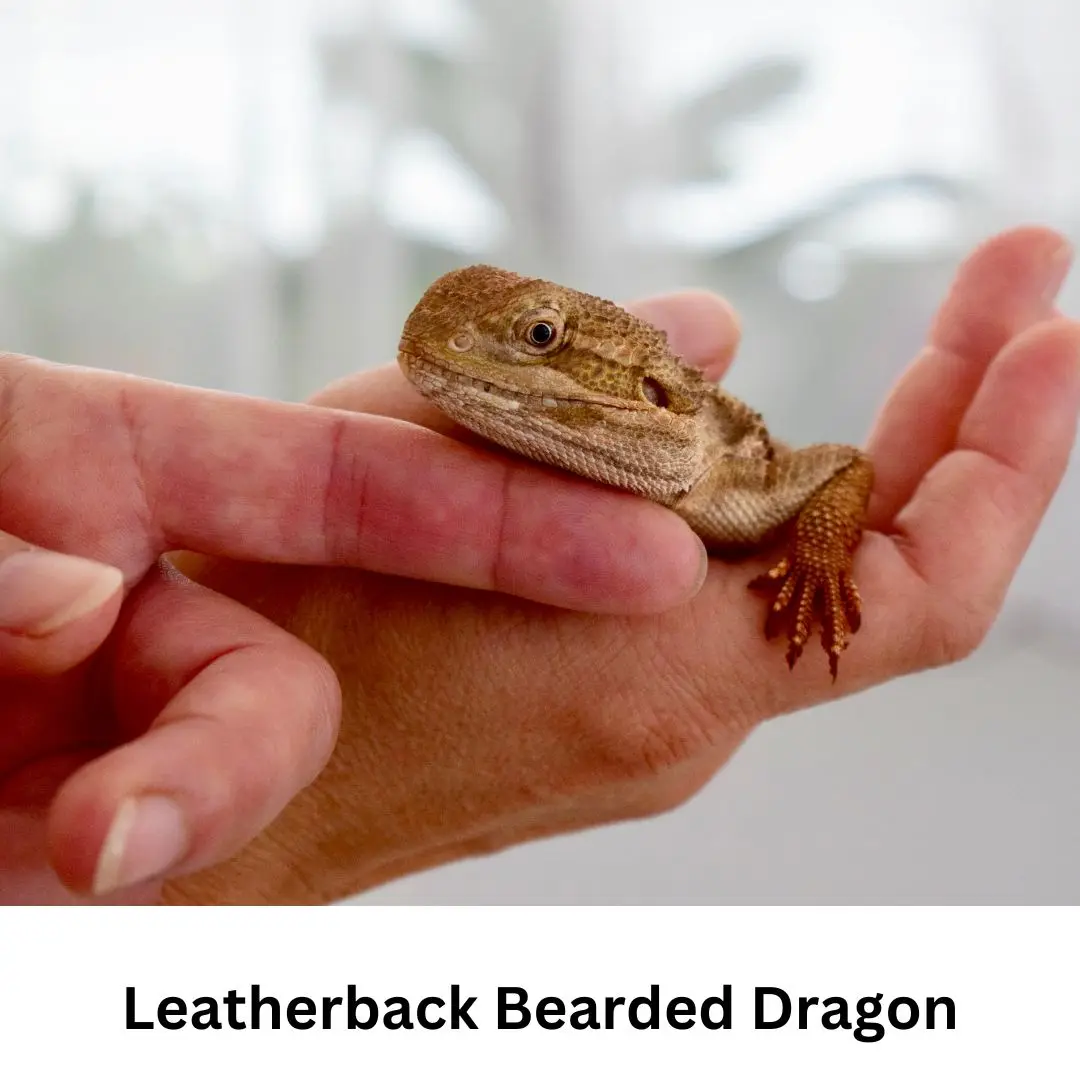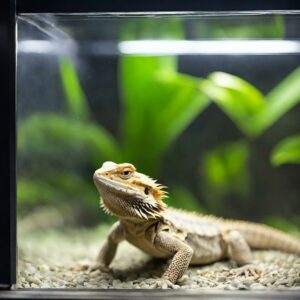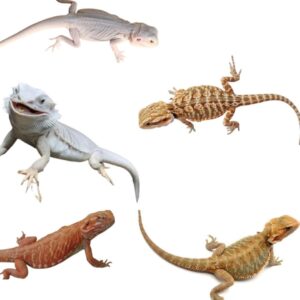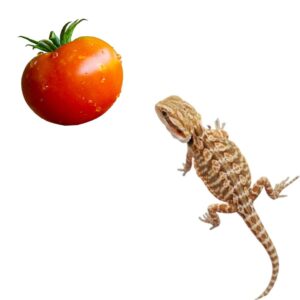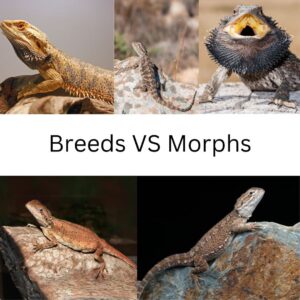The Leatherback Bearded Dragon is a type of bearded dragon with a unique smooth and leathery appearance. Unlike regular bearded dragons with larger, spiky scales, Leatherbacks have much smaller scales that are barely noticeable, giving their skin a soft, almost velvety feel. This distinctive feature is caused by a genetic mutation that affects their scale development.
This article will explore various aspects of the leatherback bearded dragon, including its origin, physical characteristics, lifespan, and caring requirements. We will mention its behavior, temperament, and suitability as a pet.
So, let’s dive into the world of the leatherback bearded dragon.
Leatherback Bearded Dragon: Table of Contents
Leatherback Bearded Dragon: Quick Overview
- Scales: As mentioned before, their most striking feature is their smooth, leathery skin. They have much smaller scales than regular bearded dragons, and the spikes on their back are also less prominent.
- Colors: Leatherback Bearded Dragons come in various colors and patterns, just like regular bearded dragons. Some common colors include orange, yellow, red, and brown. They can also have stripes, spots, and other markings.
- Temperament: Leatherback Bearded Dragons are generally known for being docile and easy to handle. They make good pets for both experienced and beginner reptile owners.
- Care: The care requirements for Leatherback Bearded Dragons are similar to those for regular bearded dragons. They need a spacious enclosure with proper lighting, heating, and ventilation. They also need to be fed a diet of insects, vegetables, and fruits.
There are a few things to keep in mind if you’re considering getting a Leatherback Bearded Dragon:
- Availability: They can be more difficult to find than regular bearded dragons, so you may need to do some research to find a breeder or pet store that sells them.
- Price: They can also be more expensive than regular bearded dragons.
- Health: Some Leatherback Bearded Dragons may be more prone to certain health problems, such as skin infections. It’s important to buy from a reputable breeder and have your dragon regularly checked by a veterinarian.
Leatherback Bearded Dragon Origin and Natural Habitat
The leatherback bearded dragon (Pogona vitticeps) is a species of reptile native to the arid regions of Australia.
It is a member of the agamid lizard family known for its unique appearance, differentiating it from other bearded dragon morphs.
Its natural habitat consists of arid woodlands, deserts, and semi-deserts, where it adapts to various climatic conditions. These reptiles are masters of camouflage, blending seamlessly with their surroundings, aided by their coloration and bumpy skin texture.
Physical Characteristics
One of the distinguishing features of the leatherback bearded dragon is its unique scale pattern.
Instead of the typical bearded dragon scales, these dragons have circular or oval-shaped scales, giving them a nodular or “leathery” appearance. These specialized scales make them less susceptible to injuries from rough terrains and protect them from excessive heat or cold.
The leatherback bearded dragon exhibits vibrant colors, ranging from light yellow to deep orange or reddish hues.
Their eyes are usually dark and round, further enhancing their striking appearance. These dragons have beard-like spines that flare up when they feel threatened or during courtship displays.
Lifespan and Growth Rate
When cared for properly, the leatherback bearded dragon can live for 10 to 15 years. Their growth rate largely depends on genetics, diet, and environmental conditions.
During their first year, leatherbacks experience substantial growth, reaching approximately 10 to 12 inches in length. Adults can attain an average length of 16 to 24 inches, with females slightly smaller than males.
It is important to note that providing optimal care and nutrition is crucial for their overall well-being and longevity.
In the following section, let’s explore the essential aspects of caring for a leatherback bearded dragon.
Caring for a Leatherback Bearded Dragon
Dietary Requirements
A balanced diet is essential for the overall health of a leatherback bearded dragon. These reptiles are omnivores, with their diet consisting primarily of insects such as crickets, mealworms, and dubia roaches.
However, it is important to supplement their diet with leafy greens and vegetables, providing essential nutrients, vitamins, and minerals. A calcium supplement should also be regularly included to prevent metabolic bone disease.
Ideal Living Conditions
Creating a suitable habitat for a leatherback bearded dragon is crucial for its well-being.
A spacious terrarium with a secure lid is essential to prevent escapes and ensure proper ventilation.
These dragons require a temperature gradient within their enclosure, with a basking spot maintained at around 95°F (35°C) and a cooler area ranging from 80-85°F (27-29°C).
Adequate UVB lighting is also necessary for their optimal health, mimicking their natural sunlight exposure.
Common Health Issues and Prevention
Though generally hardy, leatherback bearded dragons can be susceptible to certain health issues if their needs are unmet.
Some common health problems include metabolic bone disease, respiratory infections, and parasites. Regular veterinary check-ups and proper husbandry practices, such as maintaining clean enclosures and providing appropriate humidity levels, can go a long way in preventing these issues.
Behavior and Temperament of Leatherback Bearded Dragons
Social Behavior
In the wild, Leatherback bearded dragons prefer living solo. Their tolerance for roommates, even other Leatherbacks, depends on ample space and resources.
Remember, housing multiple males together is a recipe for territorial tensions and potentially aggressive behavior. To cultivate a healthy and trusting bond with your scaly friend, prioritize proper socialization.
Breeding Behavior
During breeding, males display head bobbing, arm waving, and darkening their beards to attract females. Females may also exhibit a change in behavior, becoming more receptive to the male’s advances. Successful breeding requires careful pairing, appropriate temperature conditions, and nutritious diets for both males and females.
Handling and Interaction
Gentle and regular handling is crucial to creating a bond with your leatherback bearded dragon.
However, it’s important to note that each dragon has its own personality, and some individuals may be more docile and receptive to handling than others.
Always approach them calmly and support their body to avoid unnecessary stress or injuries. Regular interaction with various environmental stimuli, such as new toys or climbing structures, can also help keep them mentally stimulated.
The Leatherback Bearded Dragon as a Pet
Pros and Cons
Owning a leatherback bearded dragon has its own pros and cons. On the positive side, they are generally docile and can become quite tame with proper handling and care. They make fascinating and visually striking pets, and their unique appearance will captivate reptile enthusiasts. However, it’s important to consider factors such as the commitment of time, resources, and space required to provide them with suitable living conditions.
Are leatherback bearded dragons rare?
Yes, Leatherback Bearded Dragons are considered rarer than the standard bearded dragon morph and most other common morphs, like hypomelanistic ones.
Here’s why:
- Genetic mutation: Their smooth back appearance is caused by a specific genetic mutation, and not all breeders intentionally breed for this trait.
- Breeding: Successfully producing Leatherback offspring isn’t guaranteed, unlike breeding for more common traits. This adds to their rarity.
- Demand: Their unique smooth leathery appearance makes them popular among reptile enthusiasts, further contributing to their limited availability and higher price than more common morphs.
However, its rarity can depend on several factors:
- Location: Finding Leatherback Bearded Dragons might be easier in some regions compared to others due to the presence of specialized breeders.
- Time of year: Breeding seasons and availability can fluctuate throughout the year.
- Breeder networks: Connecting with breeders focusing on specific morphs, like Leatherbacks, can increase your chances of finding one.
What is the difference between a leatherback and a regular bearded?
The biggest difference between a Leatherback Bearded Dragon and a regular bearded dragon lies in their scales, making them easily distinguishable at first glance.
Regular Bearded:
- Scales: Regular bearded dragons have larger, spikier scales that give their skin a rough, textured feel. These scales are visible to the naked eye and cover their entire body, including their back, sides, and limbs.
Leatherback Bearded:
- Scales: In contrast, Leatherback Bearded Dragons have much smaller scales that are barely noticeable, giving their skin a smooth, almost velvety feel. Their name aptly describes their leathery texture. You’ll find these smaller scales primarily on their back, while their sides and limbs might have slightly larger but still smooth scales. Spikes on their back are also less prominent.
Beyond their distinctive scales, Leatherback Bearded Dragons might also exhibit slightly brighter colors compared to regular bearded dragons due to the different light refractions on their smoother skin. Their temperament and care requirements, however, are largely similar to their regular counterparts.
| Feature | Regular Bearded Dragon | Leatherback Bearded Dragon |
| Scales | Large, spiky, visible | Small, smooth, barely noticeable |
| Skin texture | Rough, textured | Smooth, leathery |
| Spikes | Prominent on back | Less prominent on back |
| Availability | More common | Less common, rarer |
| Price | Lower | Higher |
Adoption and Purchase Considerations
If you decide that a leatherback bearded dragon is the right pet for you, there are various options to consider.
Adoption from reptile rescues or reputable breeders can provide a loving home to dragons in need. It’s important to research and choose a trustworthy and experienced source to ensure the health and welfare of the dragon you bring into your home. Properly acclimating them to their new environment and providing ongoing care and enrichment is essential for their well-being.
In conclusion, the leatherback bearded dragon is a captivating reptile species with unique physical characteristics and captivating behavior. These dragons can make fascinating and rewarding pets with proper care and understanding of their needs. However, responsible ownership and a commitment to meeting their care requirements are crucial to ensure their well-being and longevity. So, if you are considering adding a leatherback bearded dragon to your family, be prepared to embark on an exciting journey filled with wonder and awe.
My Senior Paws is a participant in the Amazon Services LLC Associates Program, an affiliate advertising program designed to provide a means for sites to earn advertising fees by advertising and linking to Amazon.com. We also participate in other affiliate programs which compensate us for referring traffic.
